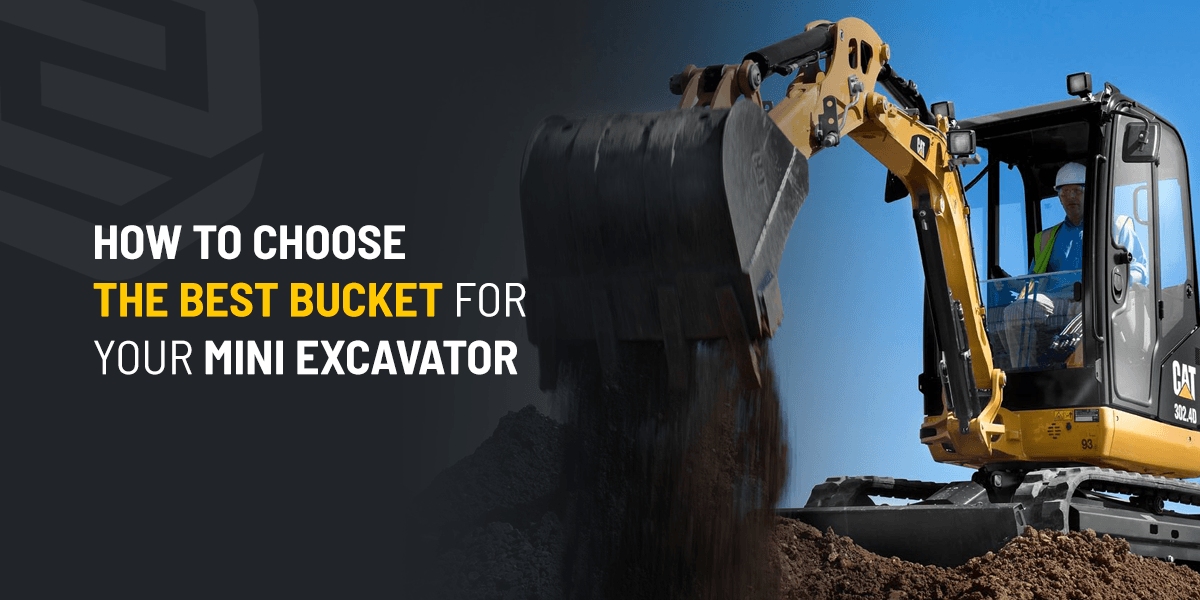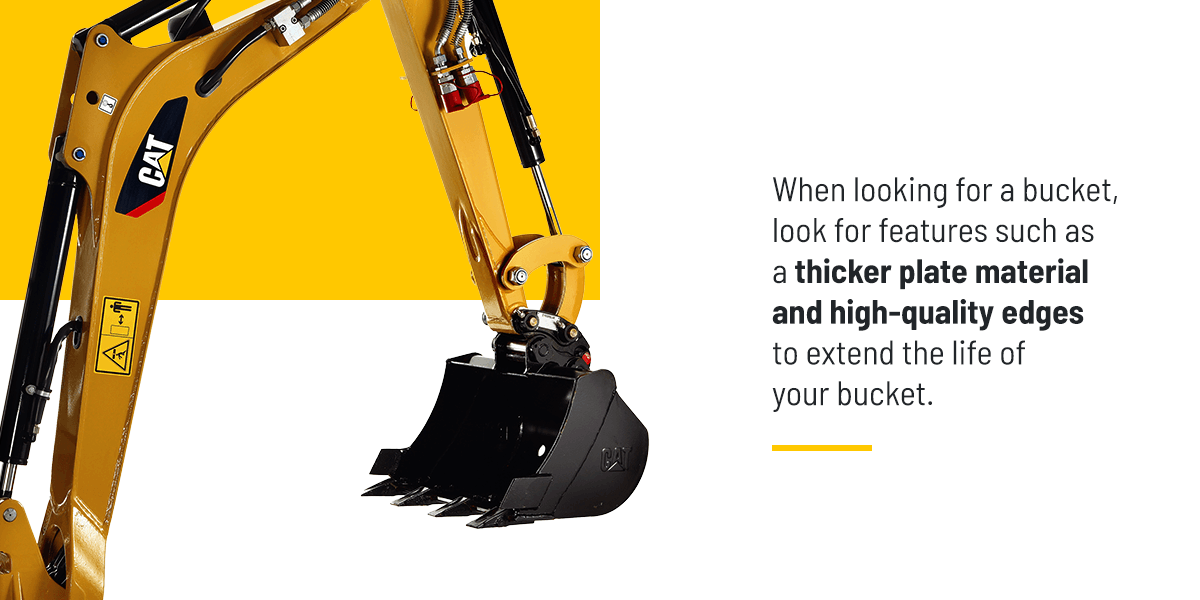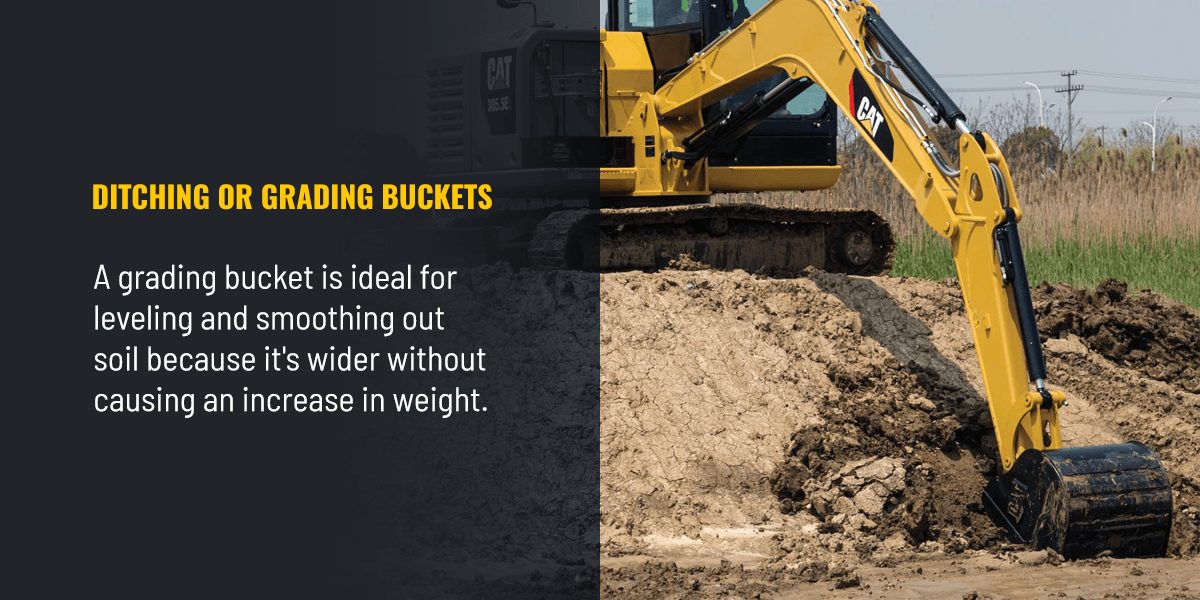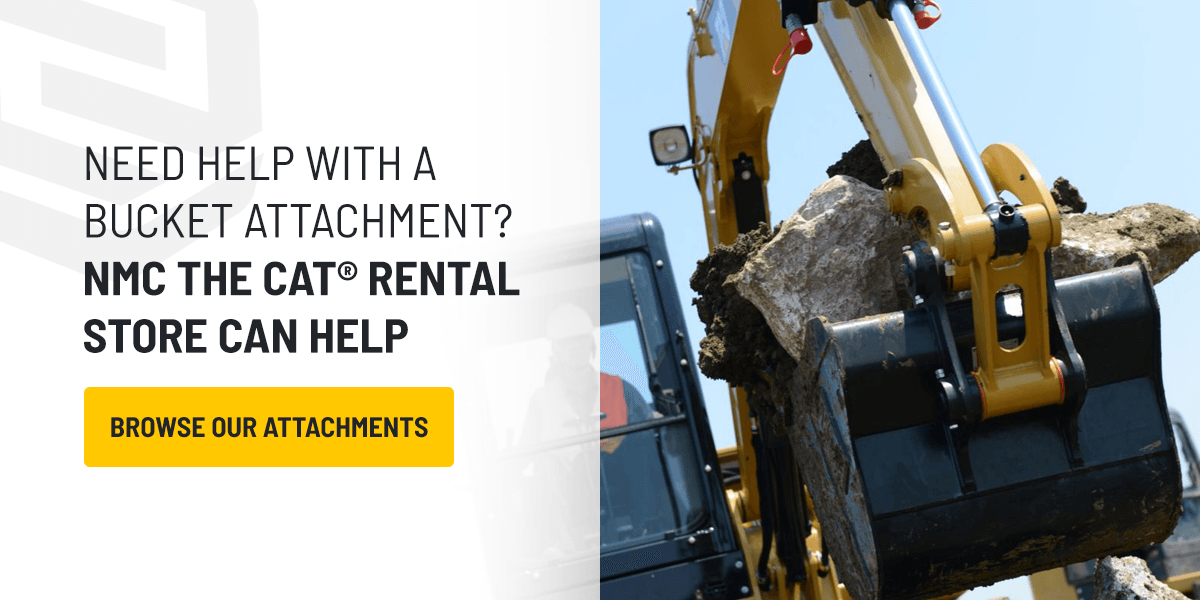
How to Choose the Best Bucket for Your Mini Excavator
Category: Equipment and Solutions
After securing a new job with a successful bid, your next step is ensuring you have all the proper equipment. Once you narrow your search down to a mini excavator, the next step is to find the ideal bucket for the job. Choosing the best mini excavator bucket for your job site will ensure your crew is successful and you complete the job efficiently.
Tips for Choosing a Mini Excavator Bucket
As you begin your search for a mini excavator bucket you may ask questions such as are all mini excavator buckets universal? While it can be tempting to use one bucket for all your needs, this may lead to lower levels of efficiency as not all mini excavator buckets are the same. Before you select a bucket, here are some questions to consider:
1. What Material Are You Moving?
When choosing a bucket for your mini excavator, the first thing you must consider is the soil condition of the job site. If you are working in various soil conditions such as clay, gravel, sand, or shale, you may want to consider using an abrasion-resistant and durable heavy-duty bucket.
Severe-duty buckets are an ideal option for job sites that feature abrasive materials or severe digging. A severe-duty bucket features abrasion-resistant material to promote uptime. Ensuring your mini excavator bucket is compatible with the material you need to move is an essential first step.
2. What Size Bucket Do You Need?
Many believe that the bigger the bucket, the more efficient you will be. While a bigger bucket may hold more material, a smaller bucket may allow your excavator to cycle faster, especially when lifting heavy material. To find the best bucket size for you, identify the capacity of your excavator. Then determine how many loads you will need to move each day before selecting a bucket size that can handle these demands.

3. Which Bucket Fits Your Needs?
The right bucket features can help you get the job done more efficiently. When looking for a bucket, look for features such as a thicker plate material and high-quality edges to extend the life of your bucket.
4. Are You Adding Accessories?
To enhance your excavator for your job site, you can customize your bucket with various add-on accessories. Adding accessories such as teeth to your bucket or changing the edge configuration can improve how your excavator operates in many different soil types. You also have the option to add additional protective accessories to expand the lifespan of your bucket.
What Are the Different Types of Excavator Buckets?
Once you determine the conditions of your job site and your needs, selecting your bucket from the many different types available is a simple process. The different mini excavator bucket types are:
Standard Buckets
Standard buckets or digging buckets are a popular option and are available in a variety of mini excavator bucket sizes. These buckets are ideal for general excavation and feature short, blunt teeth for greater versatility. If you rent an excavator without specifying which type of bucket you need, you will most likely receive a standard bucket. This bucket is ideal for materials such as:
- Dirt
- Sand
- Topsoil
- Soil with small stones
- Clay
Heavy-Duty Buckets
As the name may imply, heavy-duty buckets are ideal for more challenging jobs that require stronger equipment that can carry larger loads. You also have the option to add accessories to your heavy-duty buckets, such as wear plates and strips to increase your bucket’s lifespan. A heavy-duty bucket is ideal for moving materials such as:
- Blasted rock
- Stone
- Shale
Severe and extreme heavy duty buckets can handle heavier materials such as:
- Limestone
- Sandstone
- Basalt

Ditching or Grading Buckets
Grading and ditching buckets are essentially the same type of bucket. The main difference between calling it a ditching bucket versus a grading bucket depends on the job you’re performing. For example, you’ll use a grading bucket to level out and smooth the ground. A ditching bucket, on the other hand, is what you’ll call a grading bucket when you use it to dig out ditches or land drains. This type of bucket has a smooth front edge, unlike the sharp teeth of a standard bucket.
A grading bucket is ideal for leveling and smoothing out soil because it’s wider without causing an increase in weight. A ditching bucket is better suited for maintaining ditches and in construction because it has a smooth front edge. This bucket type is ideal for soil that’s free of roots or rocks.
Tilting Buckets
One of the most frequent uses of a tilting bucket is in grading applications due to its ability to tilt up to 45 degrees. These buckets also allow an excavator to move or shape land without the need to frequently change positions. Some additional applications of this bucket include:
- Trenching
- Clearing land or snow
- Finishing
- Digging in hard-to-reach areas
Cemetery Buckets
The primary use of a cemetery bucket is to dig graves, flat bottom trenches, pools and basements. These buckets have a lower capacity than standard buckets and will allow the operator to dig holes with straight walls and flat bottoms. Since these buckets are wider and not as deep, they are not an ideal choice for general construction work.
Rock and Coral Rock Buckets
Rock and coral rock buckets are ideal for digging highly abrasive materials such as rocks. These buckets are an aggressive option and can quickly excavate frozen ground or layered rock. Compared to other bucket options, a rock and coral rock bucket is heavier with more teeth and wear pads on the bottom of the bucket to increase digging force.
Renting or Buying a Bucket?
It is a good idea to rent your excavator bucket instead of buying a new bucket for your specific needs. If you plan to use your bucket for multiple jobs, you may want to consider purchasing a used excavator bucket to save money. Whether you pursue either option, here are some elements to look for before making any financial decisions:
- Cracks or dents: Examine the weld points for cracks or dents in the bucket. If there is a fissure in the welding, you will see a fringe of rust.
- Rust: Rust is one of the top signs of excessive wear in your bucket. Depending on the severity of the rust, you may be able to refurbish your bucket.
- Scalloping: Over time, the teeth on a bucket will wear down to resemble a half-moon shape. While these teeth are still operational, they will not be as efficient and may require replacing soon.
- Fit: Before making any purchasing decisions, your bucket must fit your mini excavator. A bucket that is too heavy will reduce efficiency or damage your machine. Check that your bucket is the right size and weight for your excavator before attaching it to your machine to see if it fits properly. You also have the option to open and close your bucket or dig with your bucket to ensure everything is operating correctly.
Need Help With a Bucket Attachment? NMC The Cat® Rental Store Can Help
Learn more about our available bucket attachments for mini excavators today. Contact us at 800-628-6025 to speak with one of our knowledgeable representatives or order online today!

